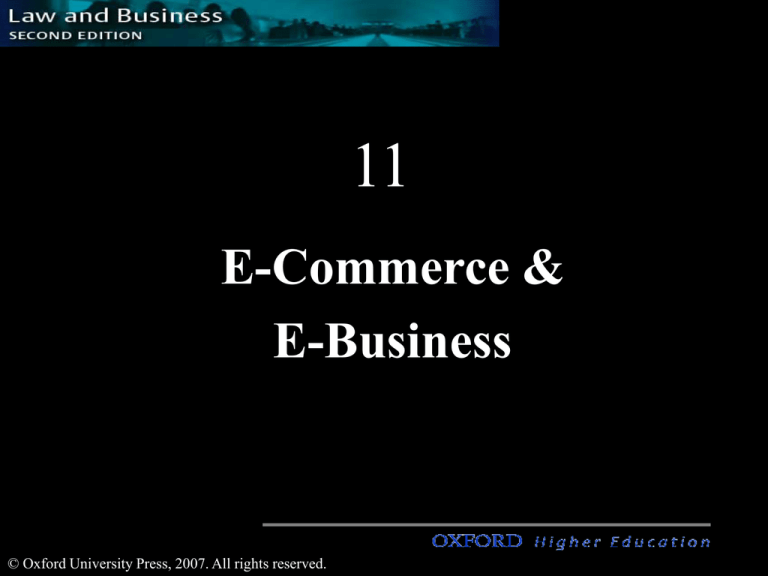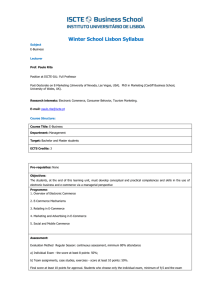
11
E-Commerce &
E-Business
1
© Oxford University Press, 2007. All rights reserved.
Introduction
Contracts have been increasingly used over the internet for
purchases and sale of goods, services as a license. These
contracts have generally been referred to as “e-commerce”.
However , strictly speaking not all agreements over the internet
are “e-commerce”. Only transactions which involve the
purchase and sale of goods and services over the internet are ecommerce.
License agreements where no money is exchanged are on-line
agreements.
2
© Oxford University Press, 2007. All rights reserved.
Computer and Internet Access in
Australia
3
© Oxford University Press, 2007. All rights reserved.
Contracts on the web
Types of contracts on the web
TYPE 1 : E-commerce contract between a web-buyer and webseller involving the purchase and sale of a good or service over
the internet.
TYPE 2 : License agreement between the web-hoster and webuser. No money is exchanged here and no good or service is
purchased.
TYPE 3: Purchase and sale of goods between two suppliers for
the purposes of re-supply. Here there is no consumer.
4
© Oxford University Press, 2007. All rights reserved.
Contracts on the web cont…
Characterising the different types
E-Commerce Agreements: Contracts are e-commerce ventures
involving consumers and web-sellers of goods and services.
On-line Licence Agreements: Contracts are on-line licence
agreements authorising web-users access to the company’s web-site.
Typically there are no sales or purchases and no money is exchanged. The
company is merely using the web-site for advertisements and publicity.
E-Business Agreements: Contracts are e-business contracts and do not
involve consumers. Typically they involve the purchase & sale for the
purposes of re-supply.
5
© Oxford University Press, 2007. All rights reserved.
Elements of an E-Commerce & E-Business
Contract
Web Offer
The offer on the web-site needs to be distinguished from non-offers
such as invitations to treat. To determine whether an offer has
been made use the reasonable person test (objective).
Need to distinguish the non-offers:
• Web-advertisements
• Electronic price lists
• Electronic catalogues
6
© Oxford University Press, 2007. All rights reserved.
Elements of an E-Commerce & E-Business
Contract cont…
Web Acceptance
The general rule is that acceptance must be communicated to the
offeror. This general rule can be displaced in special
circumstances. See:
Acceptance by conduct
A web-site user can accept by conduct by simply downloading
material (documenting the purchase of goods/services) of the
user’s web-site. Courts apply an objective test to interpret the
actions of the web-site user
7
© Oxford University Press, 2007. All rights reserved.
Elements of an E-Commerce & E-Business
Contract cont…
Acceptance by mouse-click
A web site user may reach a binding legal agreement by accepting the web
site offer with a mouse-click. For the consumer to be bound the acceptance
must be unequivocal and relate back to the offer. The owner of the web site
must make sure that the web site is able to validate the terms of the offer from
the viewer.
Acceptance by email
This is the most problematic in terms of timing. When does an acceptance by
email take place? At the time of sending the email (postal acceptance rule) or
at the time of receipt (instantaneous method of acceptance)? No cases have
decided the issue. The outcome will depend on the circumstances of the case.
8
© Oxford University Press, 2007. All rights reserved.
Electronic Transactions Legislation
Electronic Transactions Act 1999 (Cth)
Based on two principles:
– Functional Equivalence
– Technology Neutrality
9
© Oxford University Press, 2007. All rights reserved.
Domain names
A domain name is a mnemonic, or plain English,
expression connected to a numeric Internet Protocol
address by the relevant domain name registry
authority.
There are various levels of domain names used on the
Internet which include:
Top Level Domain (TLD) such as ".com" or ".au“
Second level domain (SLD) such as "colesonline“
Third or Fourth level domain names which are linked to a
specific internet server.
10
© Oxford University Press, 2007. All rights reserved.
Functions served by domain names
Domain names essentially serve the function of "location
identifiers". If a company wants to establish a business on the
worldwide web then it needs to register a domain name with
an alphabetical address: www.colesonline.com.au.
In Australia the main registration body is Melbourne IT (or INA)
which is currently responsible for the registration of .com.au
domain names. For .com, .org, or .net domain names network
solutions is responsible. Each country has a specific
jurisdiction over domain names and this is recognised by the
special suffix put at the end of the domain name: eg: Australia
has .au.
11
© Oxford University Press, 2007. All rights reserved.






